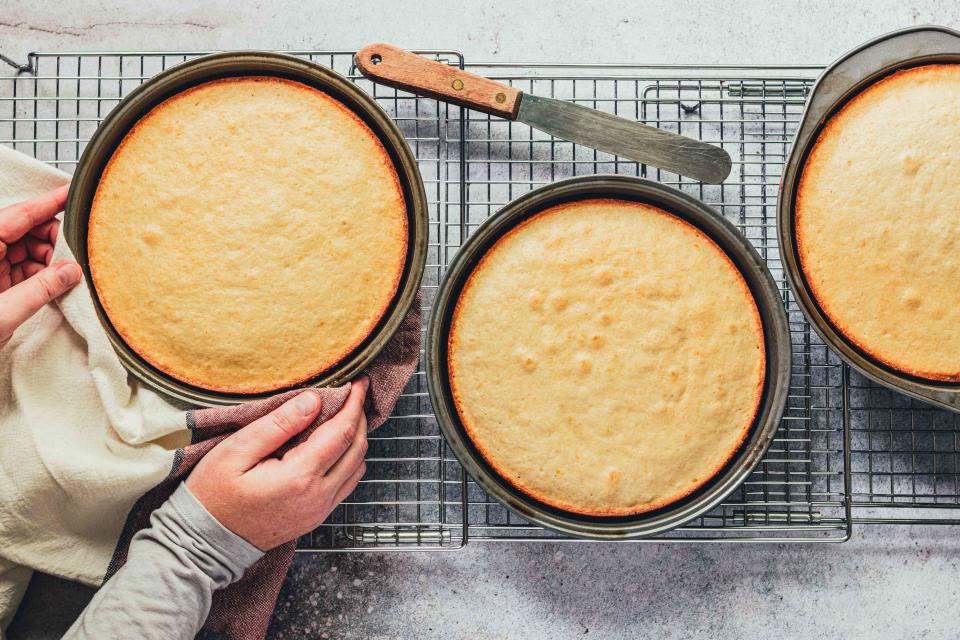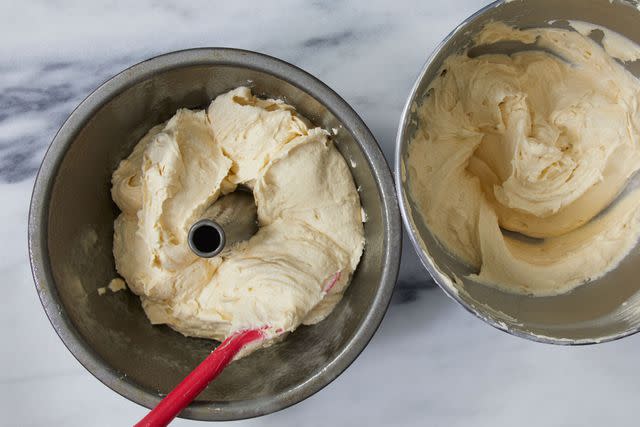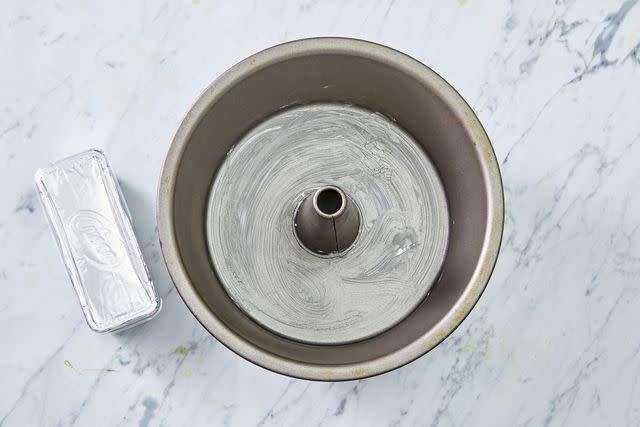Everything You Need To Know About Cake Pan Sizes And Conversions
The recipe you're baking calls for that cake pan size for a reason.

Courtney West
It's no secret that cake pan sizes are important to achieve the proper results when you're baking. That said, we’ve all been in a situation where a recipe calls for a cake pan size that isn’t on our shelf, or our ultimate goal is a round cake instead of square.
The good news is that cake pan sizes can always be adjusted using a bit of math.
"To achieve the proper result, the cake pan needs to be the right size for the amount of batter made from a recipe,” Chef Rhonda Stewart, a senior instructor and associate professor at Johnson & Wales University’s Charlotte campus, tells Southern Living. "Of course, you can always correct the yield of the batter by converting the recipe—multiplying or dividing the ingredient amounts to create a larger or smaller yield—to fit your desired pan or eventual cake size."
Meet Our Expert
Chef Rhonda Stewart, Senior Instructor/Associate Professor, Johnson & Wales University, Charlotte, NC
What To Know About Cake Pan Sizes Before You Start Baking
Recipes are written with cake pan size specifications to prevent kitchen catastrophes.
"If too much batter is put in a pan, then it will overflow during the baking process and make a mess of your oven," Stewart explains. "If too little batter is put in the pans, then the cakes will not be tall enough or may over bake if you strictly adhere to the listed baking time."
Stewart says that no matter what size pan you use, you should always check your cakes well before the instructed baking time ends. Each oven is different and could easily bake your cake faster than what the recipe tells you.
Standard Cake Pan Sizes
If a recipe calls for a standard-sized pan, it's important to know what that means.
Round pans: Usually 8 inches or 9 inches
Square pans: Also typically 8 inches or 9 inches
Rectangle pans: 9 by 13 inches or 11 by 15 inches [for] sheet or jelly roll pans
Loaf pans: 9 by 5 inches
All these pans are typically one and a half to two inches tall.
Stewart adds that cupcake pans typically come in standard, miniature, and jumbo.
Related: How To Make A Layer Cake When All You Have Is A Sheet Pan
How To Convert Cake Pan Sizes
If a recipe calls for a square pan, but you only have a round one, you’re in luck. Stewart tells Southern Living it’s "absolutely" possible to convert cake pan sizes and achieve desired results.
"A square pan has more volume than the same dimension of a round pan, and therefore the batter yield from a recipe for a square pan would be too much for the same dimension round pan," she says. "It requires a little bit of math: If you have an 8- x 8- x 2-inch square pan, you have a volume of 128 cubic inches. An 8- x 2-inch round cake pan has an approximate volume of 100 cubic inches. To convert, you divide the required size by the existing size. So, you would divide 100 cubic inches by 128 cubic inches. This gives you a conversion factor of 0.80. You would then multiply the amount of each ingredient by 0.80 to achieve the new recipe amount that would fit your round pan."
If the math is making your head spin a bit, Stewart offers a simple solution: "A recipe that makes three 8-inch layers will make two 9-inch layers, one 13-by-9 inch sheet, or three to four dozen cupcakes."

Dotdash Meredith
Cake Pan Materials
Shopping for cake pans can become overwhelming. Cake pans come in a variety of materials, shapes and styles, and each variation provides different results. Stewart says this is a small sampling of the variations available for consumers:
Materials: silicon, aluminum, non-stick, glass, ceramic
Shapes: round, square, rectangular, oval, hexagonal,
Styles: molded, cake rings, tube, removable bottom and springform
Home Cake Pans vs. Bakery Cake Pans
When it comes to professional bakers, cake pan sizes vary to yield specific results for a sellable product. This size variation could depend on packaging, customer preference and possible requirements of a wholesale account.
"A quarter-sheet pan is 8 by 12 inches, a half-sheet pan is 12 by 16 inches, and a full sheet pan is 16 by 24 inches, which would not fit in a typical home oven," Stewart explains. "Round pans range in size from 4 inches to 16 inches. This variation provides sizes that would be appropriate for a specialty cake used for a wedding, anniversary, or another celebration.”
Professional bakeries also tend to use taller pans, such as 3 inches or 4 inches in height.
"This creates a taller cake which would then need to be sliced into layers to create space for icing or filling between each layer," Stewart explains. "Most home cake pans are much shorter so the somewhat-tricky horizontal slicing of the cake is not required. Each layer is baked individually, then stacked with filling or icing to create a traditional layered cake.”
What Determines the Size of the Cake Pan Used?
Stewart says the desired end result determines the size of the cake pan you should use.
"The amount of batter can always be adjusted to fit the pans and the size of the cake you need," Stewart says. "If you are looking for a petite 6-inch cake for a small gathering, reduce your batter amount to fit the pan."
Related: The 10 Best Cake Pans on Amazon, According to Thousands of Home Bakers
Tips For Choosing The Right Size Cake Pan
Stewart, a certified executive pastry chef by the American Culinary Federation, has three important tips for working with cake pans.
Follow the recipe. "Most recipes provide the correct size pan for the yield of batter created by the recipe," she says.
Pan preparation matters. "You spend a lot of time making the batter, you want to be able to safely remove the baked cake from the pan," Stewart says.
Make sure you properly care for your cake pans. "If you purchase good quality pans, think about them as an investment," she says. "Avoid using abrasive materials or scratching the pans, and always thoroughly clean and dry them after each use. Dried on bits of a previously baked cake can affect how well your fresh cake releases from the pan."

Antonis Achilleos; Food Stylist: Chelsea Zimmer; Prop Stylist: Christine Keely
How To Prep a Cake Pan for Use
After determining the appropriate size, preparing a cake pan is one of the most important steps to ensure a properly baked cake. Stewart recommends coating the inside of the pan with a solid fat like unsalted butter or shortening.
"Dusting flour over the fat also helps prevent sticking," she says, adding that using a pan spray also helps coat the pan. "Additional flour is not always needed but can provide an extra layer of protection."
Another method involves lining the bottom of the pan with a piece of parchment paper that is cut to fit the exact dimensions of the pan. The batter can go directly on parchment paper and no additional pan spray or fat is required.
"Once the cake is baked and cooled, slide a sharp knife around the edge of the pan to release the sides of the cake from the pan," Stewart explains. "Turn the pan upside down onto a plate or cooling rack and it should slide right out. Peel the parchment paper off the bottom before icing the cake."
For more Southern Living news, make sure to sign up for our newsletter!
Read the original article on Southern Living.

